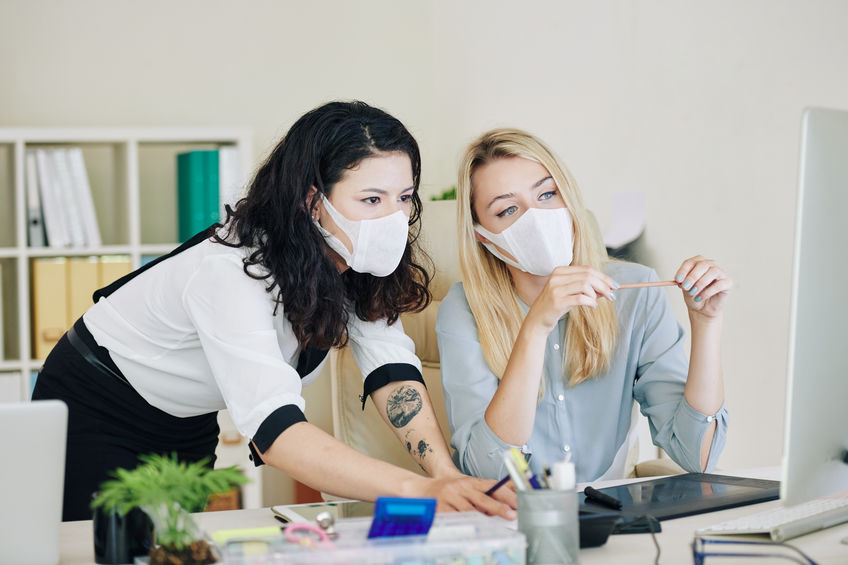Many people are staying at home as much as possible, avoiding mass gatherings and practicing social distancing. They haven’t shown any symptoms that would indicate they have COVID-19. But should they wear a mask when they make that quick trip to the grocery store?
According to a new research study from Arizona State University, the answer is yes.
People can spread COVID-19 to others, even if they don’t feel sick. Wearing a face covering over the nose and mouth can be effective in protecting other people in case the wearer is affected but doesn’t show symptoms. If the wearer is healthy, a face covering also helps to prevent them from being infected by others.
A team of professors, postdoctoral scholars and graduate students from the School of Mathematical and Statistical Sciences has developed mathematical models for face mask wearing by the general population. They found that if most of the population consistently wears masks in public, then even homemade face coverings can meaningfully reduce community transmissions of COVID-19 and decrease peak hospitalizations and deaths.
Mask wearing alone will not do much to solve the pandemic. But when combined with other measures, such as social distancing, that decrease transmission, the study shows masks nearly equally protect wearers from both transmitting or acquiring infection.
ASU’s math biology research group recently shifted its focus from understanding the effect of climate change on the transmission dynamics of vector-borne diseases, such as malaria, West Nile virus and Dengue fever, to COVID-19 and has several research studies in development.
In just two weeks, the team was able to produce the study published today in the Journal of Infectious Disease Modeling titled “To mask or not to mask: Modeling the potential for face mask use by the general public to curtail COVID-19 pandemic.” The study was supported in part by funding from the Simons Foundation and the National Science Foundation.
Steffen Eikenberry is a postdoctoral scholar and one of the lead authors of the study.
“Without symptoms, you don’t know if you are infected, and you don’t know if the person standing nearby is either. By wearing a mask you’re protecting yourself, as well as protecting others,” Eikenberry said. “The more people wear masks in public, the bigger the benefit is for the overall community.”
With personal protective equipment for health care workers in short supply, Eikenberry emphasizes that the more effective N-95 type masks should be reserved for medical personnel and those on the front lines, rather than the general public.
Mask use by the public is far more common in many Asian countries, such as China and Taiwan. In the U.S., mask use by the public in public spaces has been controversial, although recently the U.S. Centers for Disease Control (CDC) has started recommending the public wear cloth masks.
Mathematical modeling has been influential in providing deeper understanding on the transmission mechanisms and burden of the ongoing COVID-19 pandemic, contributing to the development of public health policy.
The researchers explored the communitywide impact of public use of face masks on the transmission dynamics and control of the COVID-19 pandemic by adapting previously developed SEIR model frameworks.
SEIR is a compartmental model that is used to simplify the mathematical modeling of infectious disease. The population is divided into “compartments” with the assumption that every individual in the same compartment has the same characteristics. SEIR consists of four compartments: S for the number of susceptible, E for the number of exposed, I for the number of infectious, and R for the number of recovered.
The team developed a two-group model, which divided the total population into those who wear masks in public all the time, and those who do not. They examined mask effectiveness and coverage (what fraction of the population wears masks) as their two primary areas of interest.
The researchers found that the product of mask effectiveness and coverage level strongly predicted the effect of mask use on disease outcomes. Homemade cloth masks worked best when a high percentage of people wear them in public. They also found that delaying the adoption and widespread use of mask wearing too long may undermine its effectiveness.
ASU Foundation Professor Abba Gumel is proud of his team’s work to help the greater community.
“It is in ASU’s charter, that we should be doing research of public value and assuming responsibility for the overall health of the communities we serve,” Gumel said.
“Our math biology modeling group has been working extremely hard to produce top quality COVID-19 research because we truly care about our communities.”
“It is remarkable the way our students and faculty have responded to this global challenge,” said Al Boggess, director of the School of Mathematical and Statistical Sciences at ASU. “In a very short amount of time, they have developed ways to address the needs not just of our state, but of those throughout the nation.”
The team performed simulated case studies using mortality data compiled by Center for Systems Science and Engineering at John Hopkins University from Jan. 22, 2020, through April 2, 2020, for New York and Washington state. The case studies again showed that mass adoption of even poor quality homemade masks has a positive benefit. The relative benefit was greater in Washington state, where baseline transmission is less intense. But the potential for saving lives is still greater under the more intense transmission dynamic in New York state.
The hypothetical mask adoption scenario suggests that if 80% of people wear moderately (50%) effective masks, this could prevent 17-45% of projected deaths over two months in New York. The communitywide benefits are greatest when mask coverage is as near universal as possible (at least 80% of people wear masks all the time in public).
In Washington, where baseline transmission is much less intense, 80% adoption of low quality (20% effective) masks could reduce mortality by 24-65%, and peak deaths 15-69%.
The researchers emphasize that masks should not be viewed as an alternative but as a complement to other public health control measures including social distancing, consistent hand-washing, self-isolation, etc.
Delaying mask adoption can also be detrimental. Even in areas or states where the COVID-19 spread is low, such as in the Dakotas, early aggressive action that includes a large percentage of the public wearing face masks may pay dividends.
Some may think that mask wearing in public is primarily useful in preventing asymptomatic wearers from transmitting the disease. But masks are valuable as both source control and primary prevention. This is important, as some people who have self-isolated for prolonged periods may reasonably believe that the chance they are asymptomatically infected is very low and therefore they do not need to wear a mask if the go out in public. The results of this study indicate they, and the public at large, still stand to benefit.
Essential service workers, such as retail workers, emergency services, law enforcement, etc., represent a special category of concern. These individual public-facing workers may come into contact with hundreds of people per day, and in relatively close contact, such as grocery store cashiers. This close contact likely exposes the workers to many asymptomatic carriers, and they may in turn expose many susceptible members of the general public to potential transmission.
Air exposed to multiple infectious persons, such as in a grocery store, could also carry infectious particles, for which masks would be a plausible solution. Targeted, highly effective use of masks by service works may be reasonable. The researchers are looking further into this concept.
The findings of this study suggest that face mask wearing by the general public should be implemented nationwide and without delay, even if most masks are homemade and of relative low quality. This measure could contribute greatly to controlling the COVID-19 pandemic, with the benefit greatest in conjunction with other interventions that reduce community transmission, such as social distancing.




